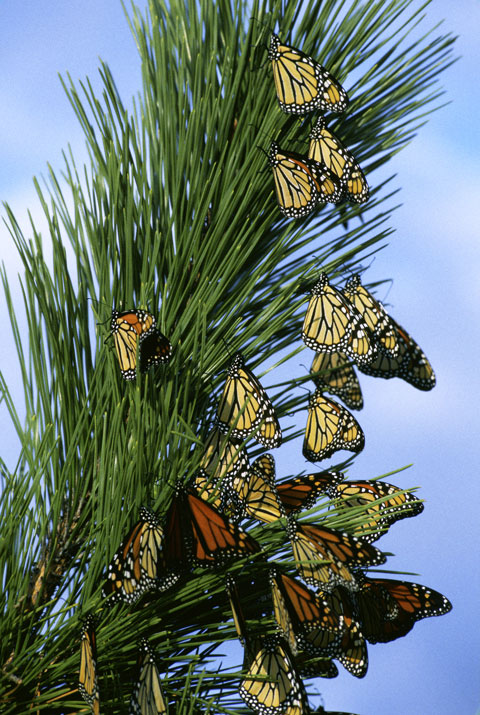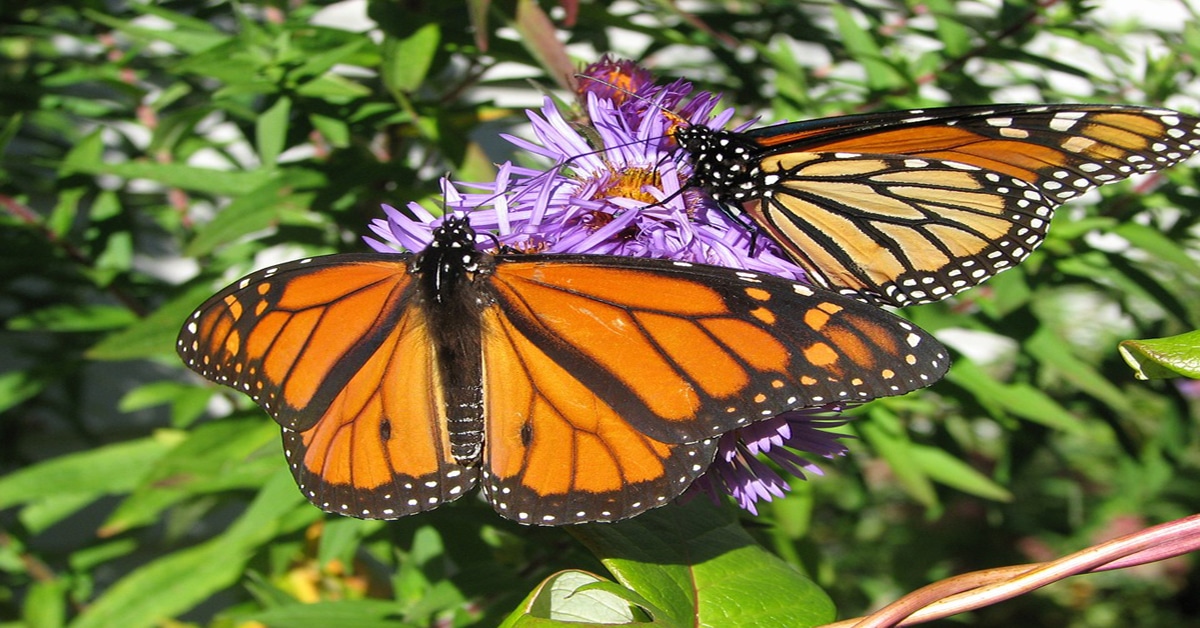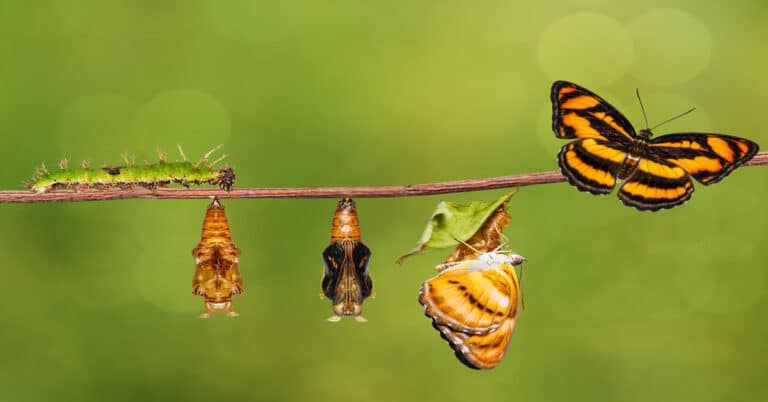Monarch Butterfly Facts
Monarch Butterflies attract a lot of attention. Many students, entomologists, and hobbyists have discovered fun facts about this species. Here are some bonus facts.
Monarch Butterfly Habitat
Danaus plexippusis basically a North American species, although our Monarchs also live in the South Pacific and have been found as strays on all continents. Other parts of the world have other species of butterflies in the genus Danaus that are sometimes called Monarchs. North American, South American, and Jamaican Monarch Butterflies can all be seen in the Caribbean.
The Other Monarch Butterflies
The genus Danaus contains twelve butterfly species. The other eleven species have body shapes, wing venation patterns, and colors that resemble our Monarch Butterflies but are noticeably different. Most are orange or brown and black as adults, and have yellow, black, white, or pale green stripes as caterpillars. Their scientific names commemorate characters in ancient literature.
- Danaus affinis, the Malay Tiger, is found in Thailand and Australia and on the islands between.
- Danaus chrysippus, the African Monarch, is found in Asia and Australia as well as Africa.
- Danaus cleophile, the Jamaican Monarch, is found between Jamaica and Hispaniola in the Caribbean.
- Danaus dorippus has sometimes been considered a variation of D. chrysippus but is currently accepted as a distinct species based on DNA studies. Its home is eastern Africa, and it sometimes flies to India.
- Danaus eresimus and Danaus plexaure are now often considered to be two names for one species found in southern Florida.
- Danaus erippus is the South American Monarch.
- Danaus genutiais sometimes called the Indian Monarch though its primary habitat is Myanmar and the islands southward to Australia.
- Danaus gilippus, The Queen, is found in the south-central States. It is smaller and browner than the Monarch.
- Danaus ismare, the Ismare Tiger, is found in southeast Asia.
- Danaus melanippus, the White Tiger, is also found in southeast Asia.
- Danaus petilia, the Lesser Wanderer, lives in Australia.
Monarch Butterfly Life Cycle

Like all butterflies, Monarch Butterflies go through a complete metamorphosis with four general stages: egg, larva (caterpillar), pupa (chrysalis), and adult. You can color in drawings of each one on the Monarch Butterfly coloring pages linked here.
Monarch Butterfly Eggs
Upon hatching, a baby Monarch Butterfly’s first move is to eat the shell out of which it hatched.
Monarch Butterfly Larvae

Like all caterpillars, Monarch Butterfly caterpillars eat and grow until they burst out of a small skin into a bigger one. Monarchs go through five skins (instars). Sometimes a caterpillar eats its exuvium (old, outgrown skin).
Depending on the temperature, Monarch Butterfly caterpillars can spend five days in one skin, or grow through all five skins in less than two weeks. In warm weather they may be ready to pupate nine days after hatching.
All caterpillars are very hungry. Monarch Butterfly caterpillars grow bigger than most North American caterpillars do, and munch faster. In the fifth instar, when they are three inches long, they can eat a milkweed leaf in five minutes.
By the time they are ready to pupate, Monarch Butterfly caterpillars can be more than 20 times as long and be described as 2700 times as big as they were when they hatched.
Monarch Butterfly caterpillars excrete digested plant material, which is called frass. People who rear them in cages have to clean the cages every two or three days.
Monarch Butterfly Pupae

Monarch Butterflies do not make cocoons. They do make silk. Before pupating they spin a little band of silk to cling to while waiting for their caterpillar skins to drop off, leaving a green inner skin called the chrysalis to harden around the caterpillar inside. The Monarch Butterfly chrysalis looks more like a big bead or a rolled-up leaf than like a living animal; this probably helps to discourage predators from eating it.
Monarch Butterfly Adults

Monarch Butterfly wings are mostly orange with black stripes along the veins. Male Monarch Butterflies can be recognized by a black spot on the upper surface of the hind wing, which female Monarch Butterflies do not have.
Monarch Butterflies do not have lungs, but have tiny vents called spiracles along the sides of the thorax and abdomen. Air enters the spiracles and is dispersed through the body by microscopic tubes called tracheae.
Monarch Butterfly wings usually span about 10 centimeters (a little over 4 inches).
Monarchs usually weigh 0.25 to 0.75 grams. It would take about 50 butterflies to weigh one ounce.
Monarch Butterflies apparently see all the colors we see and at least one more; they seem to see ultraviolet light.
Butterflies have very keen senses of smell, and Monarchs seem to smell chemicals discharged from glands in their wings. Scent probably helps them avoid places where other Monarchs are or have been, except when they are looking for mates.
When play-fighting Monarchs, unlike other butterflies, may actually make contact; the bigger butterfly may knock the smaller one to the ground. This does not harm the smaller butterfly. Monarchs approach one another when they are about to mate or hibernate, so play-fighting is probably a courtship behavior.
Female Monarch Butterflies lay one egg at a time, each egg on a separate milkweed plant if possible. Some have laid 250 eggs in one day. People who rear Monarch Butterflies in captivity have counted the total numbers of eggs laid by different females. The highest number reported so far was 1179.
Butterflies are thought to use their antennae to smell and their feet (tarsi) to taste. They pollinate flowers while extracting flower nectar with a long coiled hollow tube, called the proboscis or tongue.
Monarch Butterflies are mildly poisonous to animals that eat them. They absorb glycosides from the milkweed they eat. As a result frogs, birds, and lizards that taste food before swallowing it will spit out a Monarch. Species that gulp food down and are able to regurgitate it will usually vomit after swallowing a Monarch. Species that neither taste nor vomit will seem sick after eating a Monarch, usually survive, but show no interest in eating anything that looks like another Monarch Butterfly.
Monarch Butterfly Migration

Although they are Wanderers, individual Monarchs do not fly all the way from Canada to Mexico, and only the ones who hibernate live for even six to eight months. The Monarch Butterfly life cycle consists of about four overlapping generations a year. Most individuals spend five to eight weeks in the pre-adult stages and two to eight weeks as adults. In February and March, the butterflies who have hibernated in Mexico (or California) return to the Southern States and lay eggs. As the weather gets warmer, female butterflies follow the milkweed, and males follow the females, further north. When the weather gets colder, Monarchs gradually move south. Individuals who emerged from the chrysalis in September or October may be able to fly all the way to the favorite Monarch Butterfly groves, where, if the weather is cold enough to keep them in hibernation mode, they can rest until February. Then they have a chance to fly back to places where milkweed is growing and lay eggs.
Miraculous though it seems that a butterfly could cross the Gulf of Mexico, millions of Monarch Butterflies do that each year. By responding to the same cues their ancestors did, many find themselves hibernating in the same trees their great-grandparents used.
Monarch Butterflies fly more slowly and steadily than most butterflies do, sailing or jogging along at 12 to 25 miles per hour. Like birds, they coast on warm updrafts of air called thermals.
Not all Monarch Butterflies complete the migration pattern. While a majority of all Monarchs wander through central North America and winter at the Monarch Butterfly Biosphere Reserve in Michoac�n, Monarch Butterflies who live in the Western States hibernate in Southern California, and some individuals from the Eastern States attempt hibernation in the Southern States. These stragglers and outliers, who do not hibernate in the main Monarch Butterfly cities, may fail to complete hibernation if the weather is too warm or freeze if it is too cold, or may be the ones who preserve the species if the weather in Mexico is abnormal.
During the winter, glycosides break down and Monarch Butterflies lose some of their toxicity. By February, a mouse who has eaten one hibernating Monarch may be interested in eating another.
Monarch Butterfly Conservation
In 1986 the Mexican government set aside 62 square miles of oyamel fir groves for the Monarch Butterfly Biosphere Reserve. In 2015 the United States government designated some land in the Central States as the Monarch Butterfly Habitat Corridor. For more information about what individuals are doing to prevent Monarch Butterfly extinction, click here.

Having discovered a fondness for insects while pursuing her degree in Biology, Randi Jones was quite bugged to know that people usually dismissed these little creatures as “creepy-crawlies”.






